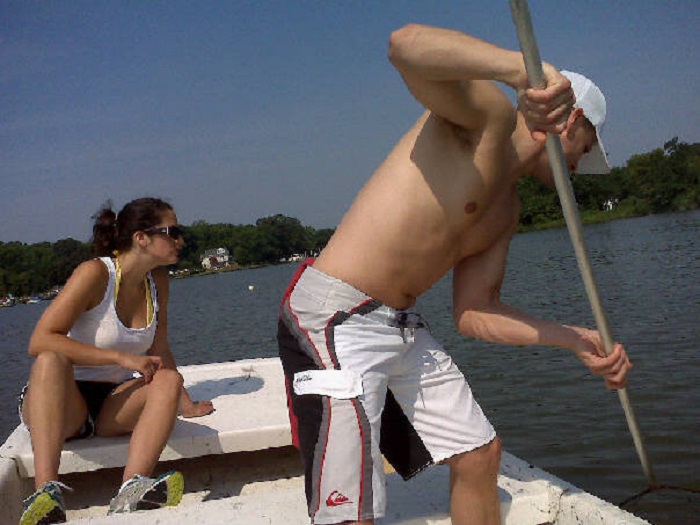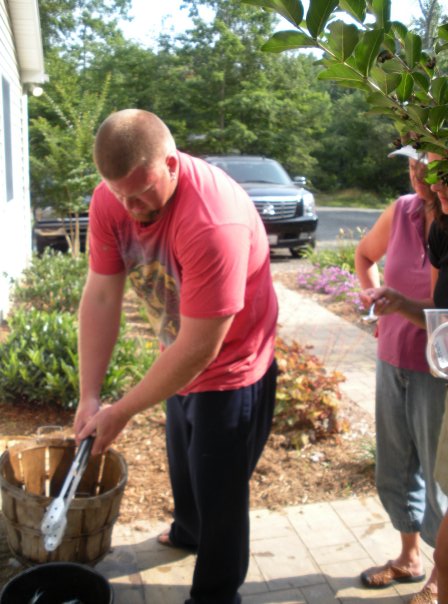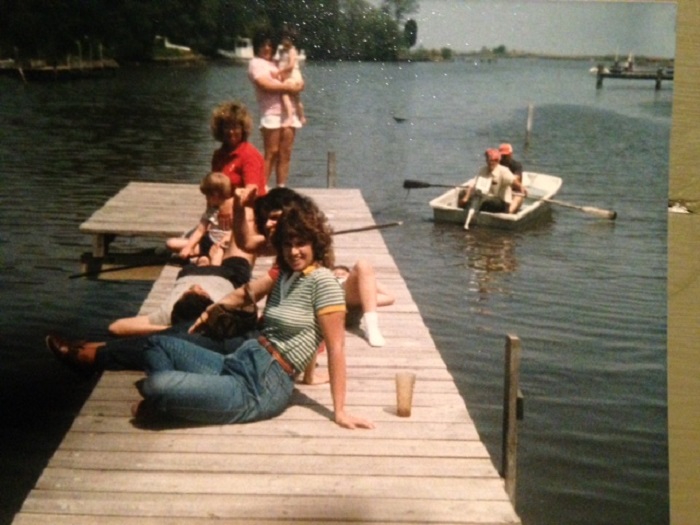Every summer, I reach into my bucket list for a couple of “must-do” activities with my kids. This summer, one of those activities was to go crabbing.

Author's grandfather with crabpots.
I grew up spending lots of time at my grandparent’s property on Parkers Creek in South County (that’s what locals call Southern Anne Arundel County). A favorite summertime activity for my brother and me was crabbing. As young children, we learned to net crabs off of the pier. As teens and young adults, we taught ourselves to run a trot line using a small skiff. These skills, practiced by generations of residents along the Chesapeake Bay, made us feel empowered and self-sufficient. There’s something about catching your own food that is rewarding and fun at the same time, and it’s an experience I wanted to share with my children.
This summer is a great time for crabbing in the Chesapeake Bay area. State officials, including those at the Department of Natural Resources, estimate that the 2016 crab population is over 550 million—one of the highest in the past two decades. There are many different ways that you can get in on the action, whether you are a local or a tourist: crab off a pier or bridge, drop crab pots into a subsidiary of the Chesapeake Bay (my grandfather’s preferred method), or run a trot line.
Crabbing with young kids
A pier or bridge is the best place to crab with young children, for obvious safety reasons. My five-year-old is a good listener and very patient, but I still don’t trust my three-year-old on a moving boat! Even while on a pier, I recommend strapping your little ones into life jackets, just in case.
To crab off a bridge, check out the Tracey’s Landing Bridge in Deale. You’ll find several people there doing the same thing. You need a cooler full of frozen chicken necks (which you can buy at any grocery store), a big spool of string, and a net. You tie the chicken neck tightly to a long string and drop it into the water, being sure to hold the other end so you can pull it up. When you see that you have a crab on your bait, pull the string up s-l-o-w-l-y. When the crab is close enough to reach with your net, scoop it up and put it in your cooler. Repeat until you’ve caught your dinner! Other pier locations include the Deale Wharf and Galesville Wharf.
If you’re not that patient, try going out with a fishing boat to drop crab pots in the water. Crab pots, if you’re not familiar, look like square, wire, weighted chicken coops that are tied to buoys. They are baited, again usually with chicken necks, and then dropped to the bottom of a creek, river or the Bay. Crabbers go out very early in the morning to drop their pots and then check them later in the day. You can catch dozens of crabs this way: very efficient!
 Author and her brother running trot line on Parker's Creek.
Author and her brother running trot line on Parker's Creek.
Running a trot line
 Author's brother places crabs into a steamer pot.
Author's brother places crabs into a steamer pot.
If you’re feeling sporty, like my brother and I, try running a trot line. It is a hoot! First, you’ll need a boat. We have a small Carolina Skiff. And you need at least two people, though three are preferred: One to run the boat, one to pull the line and one to scoop the crabs. My sister-in-law completes our trifecta. You need chicken necks (do you notice a recurring theme?), a bushel basket to contain your catch, a net, and a weighted spool of thin rope. The spool is especially useful when running the line because you have something to wrap your line around as you pull the crabs in. Otherwise you end up with a messy tangle of rope in the boat, and if you have a small boat it gets complicated real quick. When you’re still on land, unravel the spool of rope and tightly tie chicken necks on the line about every five feet. Once you’ve tied off your bait on the entire spool, wind it back up. Then take to the water! Drop your entire line in, careful to hold onto one end unless you’ve secured a buoy on the line. At this point, the driver will steer the boat up to the line. The scooper will take position with the net (usually standing, so this person needs good balance) and the third person will s-l-o-w-l-y pull in the line. When you see a crab, scoop it up. Be quick! Once crabs come to the surface they have a tendency to swim off. Trot lining is hilarious: We got it wrong so many times before we ever got it right. I’ve been pinched by loose crabs, cussed at by my brother, and knocked down by the wobbly boat. But be persistent. You are smarter than the crabs, I promise.
 Author's family on Parker's Creek, circa 1986.
Author's family on Parker's Creek, circa 1986.
I could write another blog on eating crabs, but I’ll leave it to you to figure out how to steam them and pick them. My children are warming up to the concept of crabs. I’m really proud to say that my son is an adventurous eater, so this summer may be his year! I’m a local, so smashing crustaceans does not seem odd to me at all, but I have heard it described as a “barbaric practice.” If eating them seems barbaric to you, catching them may seem even less humane, but it is a true South County summer activity and one that I hope you’ll try.
Note: For more information on hitching a ride on a charter boat, check out Visitannapolis.org’s page on local charter boat resources.
Photos courtesy of Becca Beasley.








